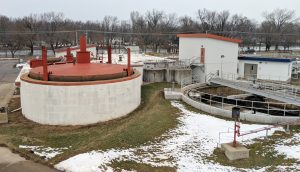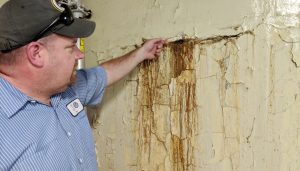But DNR’s proposed phosphorus limits concern city
By Scott Bellile
The New London City Council last month awarded a $4.38 million contract to August Winters & Sons of Appleton to upgrade the digester and waste receiving station at the wastewater treatment plant.
August Winters & Sons’ bid came in lower than an earlier engineer’s estimate of $4.56 million.
However, the city has budgeted about $4.85 million for the project. The budgeted amount factors in $254,747 in engineering costs and a 5 percent contingency of $218,915 for any problems that should arise during construction.
Sheboygan-based Donohue & Associates was awarded the engineering contract to design the improvements.
August Winters & Sons submitted the lowest bid of three companies that competed for the project.

Scott Bellile file photo
August Winters & Sons beat out the Fond du Lac firm JF Ahern Co. for the job by $1,643, an outcome City Administrator Kent Hager found surprising.
“Did you notice the difference between the low bid and the next lowest bidder? It’s 2,000 bucks out of 4.4 million dollars,” Hager told the New London Board of Public Works on Feb. 4. “I calculated the percentage, and it’s like less than one-one hundredth of a percent or something. … I don’t think I’ve ever seen anything like that close.
“If I was the second bidder, I think I’d be kicking myself in the butt,” Hager added with a laugh.
On Tuesday, March 12, the city council voted to grant New London Public Services Director Chad Hoerth the authority to approve change orders up to $50,000 without the board’s or city council’s approval.
Change orders that arise in this project would be covered by the $218,915 contingency fund, Hoerth said.
Change orders are expenditures, oftentimes unexpected, that are added to a project contract typically because construction crews encountered a problem on the job.
The wastewater treatment plant upgrade is ratepayer-funded. The city council in December approved a $1 increase in utility customers’ monthly fixed sewer rate to help pay for it.
The upgrade is slated to begin this summer and last through the end of the year.
Insight on upgrade
New London’s wastewater treatment plant was built in 1954. The facility and its digesters were upgraded in 1988 to handle more waste capacity.
Today the city considers the plant to be overbuilt due to the loss of a major customer, Saputo Inc., when the company closed its New London cheese plant in 2014. However, this upgrade will not address the plant’s abundance of space.

Scott Bellile file photo
Rather, the purposes of the project are to rehabilitate the plant’s deteriorating digester complex, which no longer complies with fire codes, and to construct a high-strength waste receiving station.
The repairs inside the digester facility will address the corroded piping, malfunctioning equipment and underperforming 33-year-old heat exchanger. The project will also restore the digester’s concrete walls where sludge is leaking through cracks.
The new waste receiving station will generate more revenue for the plant, produce methane gas more efficiently than current methods and make the plant less dependent on outside energy sources.
When septic haulers pay to dispose of their waste, the gas generated from the waste helps heat the plant’s digesters.
This would not change, but what would is that by utilizing the new receiving station, the plant could begin accepting stronger wastes such as grease traps and cheese.
Ben Greuel, chief operator of the wastewater treatment plant, said new revenues from high-strength waste haulers should pay off the upgrade within nine years.
Revenues can also be used to fund repairs and operational costs at the facility and fix sanitary sewers throughout the city.
The revenues should also lessen future rate increases for city sewer customers, as long as the Wisconsin Department of Natural Resources does not impose new regulations on wastewater treatment plants, he said.
Possible phosphorus limits concern city
Currently city officials are concerned about a DNR proposal to implement stricter limitations on the amount of phosphorus that wastewater treatment plants can release into the Wolf River daily.
The DNR plans to submit a report to the U.S. Environmental Protection Agency for review and possible approval of the proposed limits.
Phosphorus pollution accelerates weed and algae growth, thereby reducing recreational opportunities in lakes or rivers and lowering property values, according to the DNR.
The DNR says its proposed daily limits are necessary to meet water quality standards and improve public health.
In a Jan. 18 letter to the DNR, Mayor Gary Henke argued that wastewater treatment plants account for just 11 percent of phosphorus runoff into the Wolf River basin while farms are responsible for 66 percent.
“If it is known that two thirds of total phosphorus is coming from these [agricultural] areas, shouldn’t this be the main focus of the TMDL?” Henke asked in his letter, referring to the DNR’s proposed total maximum daily loads for phosphorus.
Henke wrote the proposed phosphorus limits could cost the city revenue if higher sewerage fees discourage industries from locating to New London.
Additionally, the DNR’s proposed requirements could force the city to refurbish its wastewater treatment facility at a cost of $4 million to $5 million to satisfy the lower total maximum daily load requirements, Henke stated. The expense would be passed on to city utility customers.
“This would be an additional $5.00 – $7.00 per thousand gallons of water used,” Henke wrote. “A large percentage of our community is already struggling to pay their utility bills.”
